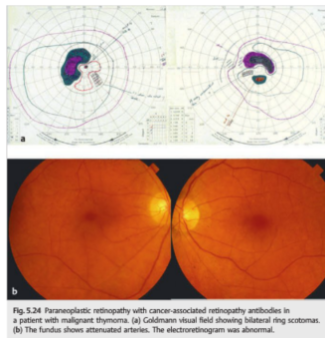Question: When should an ophthalmologist consider the diagnosis of a paraneoplastic syndrome?
 2
2
Question with answers: When should an ophthalmologist consider the diagnosis of a paraneoplastic syndrome?
“In terms of afferent symptoms, an unexplained, painless, progressive vision loss is typical. With retinal involvement, there may be photopsias, night blindness, or ring scotomas. In the optic neuropathies, there is most commonly bilateral disc swelling often accompanied by vitritis. Efferent symptoms include myasthenic-like presentation or the presence of opsoclonus/myoclonus syndrome (OMS).”1
Explanation:
“Paraneoplastic syndromes may affect the afferent and efferent visual pathways and involve the retina, optic nerve, or eye movement systems (1–6). In some cases, the neuro-ophthalmic consequences are the first indication of a malignancy, and in others, the visual pathways are affected in patients with known malignancies. The challenges are to recognize when a symptom or sign may be associated with an underlying malignant disease, to understand the diagnostic challenges in identifying an underlying paraneoplastic cause for the observed visual pathway deficits, and to determine the optimal strategy for therapeutic intervention. It is important to understand the spectrum of signs and symptoms that can result from a tumor-stimulated immune process to suspect, diagnose, and treat these diseases.
Clinical Disease Spectrum
When should the clinician consider a diagnosis of paraneoplastic syndrome? (1,6–11). In terms of afferent symptoms, an unexplained, painless, progressive vision loss is typical. With retinal involvement, there may be photopsias, night blindness, or ring scotomas. In the optic neuropathies, there is most commonly bilateral disc swelling often accompanied by vitritis. Efferent symptoms include myasthenic-like presentation or the presence of opsoclonus/myoclonus syndrome (OMS). Associated systemic neurologic symptoms, such as encephalitis, cerebellar degeneration, myelitis, or sensory neuropathies, increase suspicion for a paraneoplastic syndrome. Pertinent negatives include lack of alternative explanation for the symptoms such as a known genetic condition, history of ocular surgery, infection, trauma, mass lesion, or toxic exposures. This review does not focus on syndromes associated with anti-Hu, anti-Ma, and anti-Yo as these typically manifest with a variety of brainstem and cerebellar findings. A history of cancer may heighten the suspicion for a paraneoplastic syndrome, but the real challenge is to diagnose a potentially treatable cancer in patients who do not already carry that diagnosis.”1
“20.6.7 Paraneoplastic Syndromes
Paraneoplastic syndromes represent rare nonmetastatic complications of cancer, which can affect multiple levels of the nervous system. Autoantibodies are usually found in the CSF or serum. Paraneoplastic syndromes may complicate a known cancer or may be the first sign of a very localized cancer.
Neuro-ophthalmic symptoms and signs are relatively common and include the following:
● Abnormal eye movements
○ Opsoclonus (Ri antibodies)
○ Ocular flutter (Ri antibodies)
○ Cerebellar degeneration (Yo antibodies)
○ Nystagmus
○ Slow saccades, limited vertical movements (Hu, Ma/Ta antibodies)
● Neuromuscular junction disorder (Lambert–Eaton syndrome or myasthenic syndrome)
○ Voltage-gated calcium channel antibodies
● Visual loss
○ Retinal degeneration
– Cancer-associated retinopathy (CAR) antibodies
– Melanoma-associated retinopathy (MAR) antibodies
○ Optic neuropathy with disc edema and intraocular inflammation
– CRMP-5 antibodies
Causes of ocular flutter and opsoclonus include the following:
● Paraneoplastic:
○Neuroblastoma in children: 50% of children with opsoclonus harbor a neuroblastoma; 2% of children with neuroblastoma have opsoclonus.
○ Small cell carcinomas and other cancers associated with anti-Ri antibodies in adults
● Encephalitis, cerebellitis
● Intracranial tumor, hydrocephalus, thalamic hemorrhage, multiple sclerosis, nonketotic hyperosmolar coma, drug toxicity (lithium, phenytoin, and cocaine)
Downbeat nystagmus is caused by lesions at the cervicomedullary junction, foramen magnum, vestibulocerebellum, and medulla. It is commonly seen in cerebellar degenerations; paraneoplastic syndromes; Chiari malformation (▶Fig. 16.7); encephalitis; trauma; hypomagnesemia; thiamine deficiency; B12 deficiency; and toxicity with lithium, alcohol, amiodarone, toluene, phenytoin, and carbamazepine.”2
References:
1. Paraneoplastic Syndromes in Neuro-Ophthalmology – State of the ArtReview. Gordon J. Neuro-Ophthalmol 2015; 35: 306-314
Complete article online http://journals.lww.com/jneuro-ophthalmology/Fulltext/2015/09000/Paraneoplastic_Syndromes_in_Neuro_Ophthalmology.17.aspx
2. Neuro-ophthalmology Illustrated-2nd Edition. Chapter 20 Conditions Commonly Encountered in Neuro-ophthalmology. Biousse V and Newman NJ. 2012. Theme
These questions are archived at https://neuro-ophthalmology.stanford.edu
Follow https://twitter.com/NeuroOphthQandA to be notified of new neuro-ophthalmology questions of the week.
Please send feedback, questions, and corrections to tcooper@stanford.edu